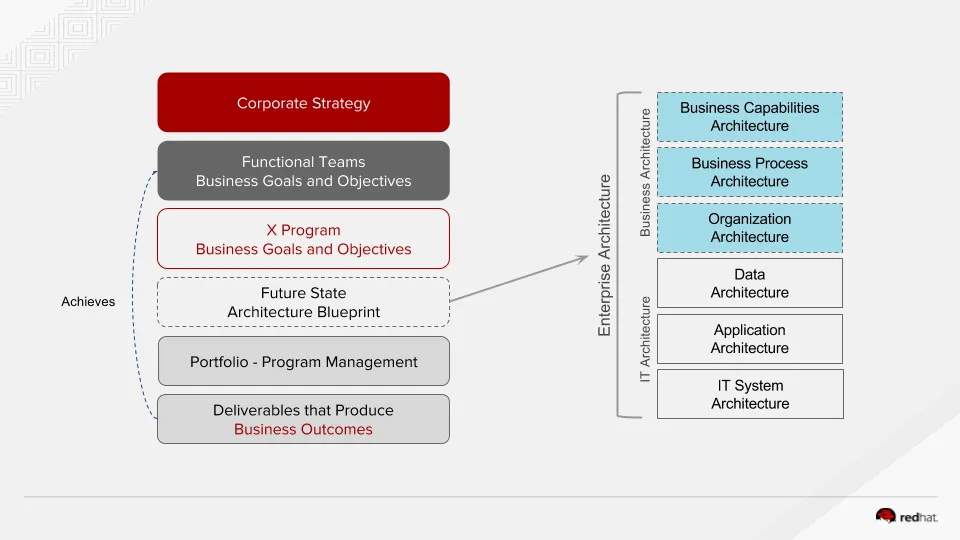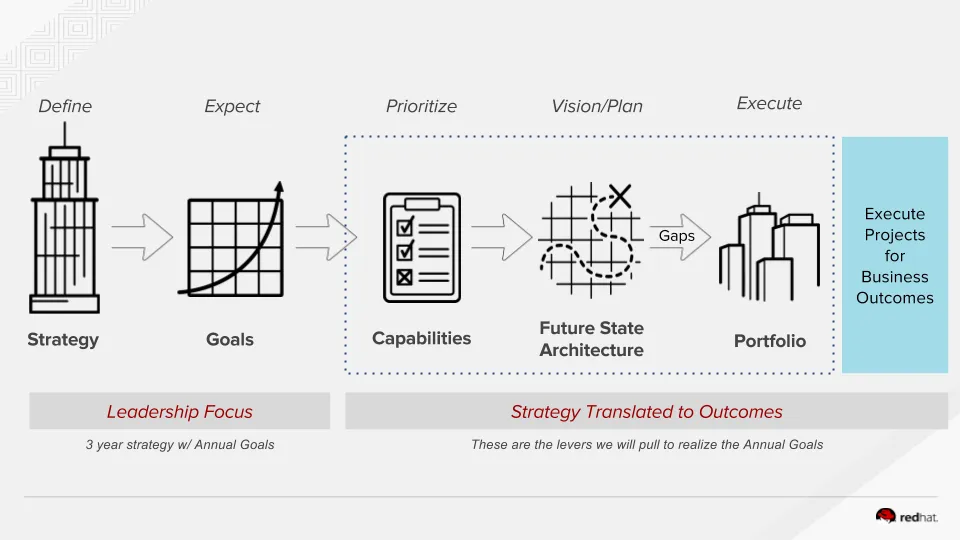Does your organization talk about connecting the execution of work to its strategy? Are you building a roadmap on how to get there and achieve desired goals? To help your organization achieve the strategy and goals, model the business architecture by understanding the organization's strategy, communicating business outcomes, and aligning these outcomes to the appropriate business capabilities.
Business architecture is illustrating what the business does and how the business operates. Gartner defines business capabilities as "what the business needs to do to achieve the business strategy.” Business architecture uses business capability modeling, to visualize and influence people, processes, and technologies needed to maximize stakeholder value, achieve organizational goals, and execute on the business strategy. This model should map out the future state capabilities needed to support where the business is going over multiple years, as defined by the organization's strategy.
Another main component of business architecture is business process design, according to Gartner, are what steps the business takes to run the business or "how a business works and/or operates." Defining the future state business processes should occur after the organization has chosen the capabilities to advance and/or deploy, in order to segway into delivering efficient and effective models that are executable and operational.
Figure 1 is a simple overview diagram that illustrates how the business architecture is aligned to strategies, goals, and business outcomes.
Business capabilities should deliver outcomes that will achieve the strategic goals set by leadership. Business process modeling define how and when the organization’s users execute the capabilities. The portfolio of work should deliver capabilities and modify processes that are defined in the organization’s collective agreement of a future state business capability model.
Figure 1
Leadership defines the strategy over a multi-year period and expects measurable annual goals or results that achieves the strategy. The business capabilities then should be documented and prioritized, and continually reviewed and improved. A vision or plan should state what the future business architecture should look like in order to effectively execute on the portfolio of work, thus start with a future state architecture before jumping into the projects or picking new technology tools. The projects in the portfolio should achieve the business outcomes that relate and measure against the strategy and goals of the organization.
The business architecture is directly integrated with the technical architecture to complete the enterprise architecture framework, as shown in Figure 2 below. This architecture framework highlights the full integration of business through technology that is achieved, in part, by showing the relationships between these components through architecture. The Business architecture, as stated previously, is made up of the capabilities and business processes mapped to the future state, as well as understanding the organization architecture, which is how the company is structured. The technical architecture is made up of the data, applications and systems that enable the business capabilities and processes to be performed and experienced by customers and partners.
Figure 2

Figure 2 is an evolution through feedback and continuously improving on the approach and modeling the architecture, as highlighted from the previous Architecture Core Diagram.
The architecture to strategy alignment is paramount to effectively plan and execute the enterprise portfolio, because it directly models the business to the multi-year business strategy and helps build a plan or roadmap to get there. The Strategy can then be translated into achieving outcomes that are the levers the entire business can pull to realize the annual goals for success.
執筆者紹介
チャンネル別に見る
自動化
テクノロジー、チームおよび環境に関する IT 自動化の最新情報
AI (人工知能)
お客様が AI ワークロードをどこでも自由に実行することを可能にするプラットフォームについてのアップデート
オープン・ハイブリッドクラウド
ハイブリッドクラウドで柔軟に未来を築く方法をご確認ください。
セキュリティ
環境やテクノロジー全体に及ぶリスクを軽減する方法に関する最新情報
エッジコンピューティング
エッジでの運用を単純化するプラットフォームのアップデート
インフラストラクチャ
世界有数のエンタープライズ向け Linux プラットフォームの最新情報
アプリケーション
アプリケーションの最も困難な課題に対する Red Hat ソリューションの詳細
オリジナル番組
エンタープライズ向けテクノロジーのメーカーやリーダーによるストーリー
製品
ツール
試用、購入、販売
コミュニケーション
Red Hat について
エンタープライズ・オープンソース・ソリューションのプロバイダーとして世界をリードする Red Hat は、Linux、クラウド、コンテナ、Kubernetes などのテクノロジーを提供しています。Red Hat は強化されたソリューションを提供し、コアデータセンターからネットワークエッジまで、企業が複数のプラットフォームおよび環境間で容易に運用できるようにしています。
言語を選択してください
Red Hat legal and privacy links
- Red Hat について
- 採用情報
- イベント
- 各国のオフィス
- Red Hat へのお問い合わせ
- Red Hat ブログ
- ダイバーシティ、エクイティ、およびインクルージョン
- Cool Stuff Store
- Red Hat Summit


